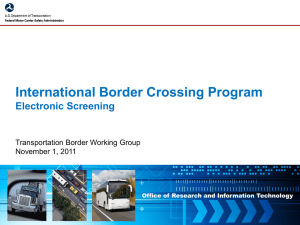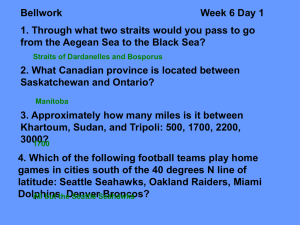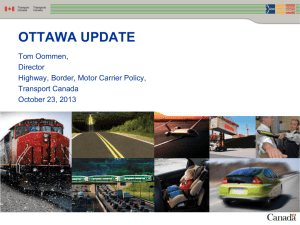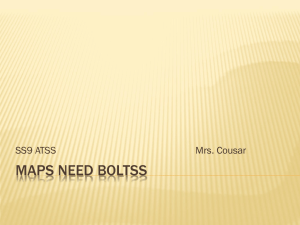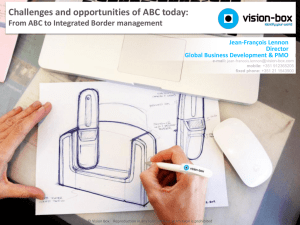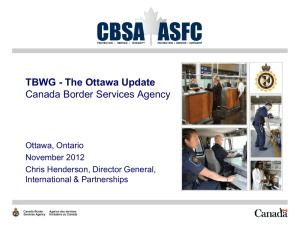Canada`s Auto Industry Current Realities and Industry Considerations
advertisement
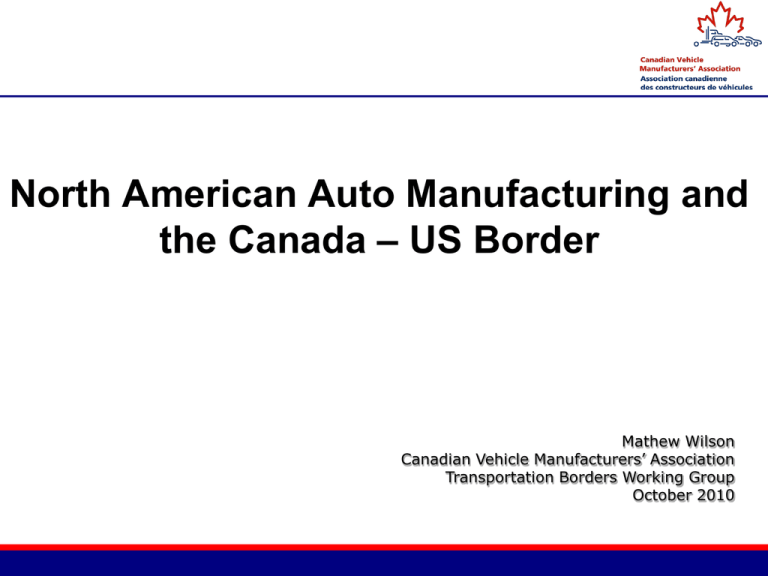
North American Auto Manufacturing and the Canada – US Border Mathew Wilson Canadian Vehicle Manufacturers’ Association Transportation Borders Working Group October 2010 Presentation Overview • Background on the CVMA and auto manufacturing industry globally • The competitive challenge of an integrated industry – why border efficiencies matter in North American auto manufacturing • Progress to date in streamlining border operations • Border realities and major challenges that remain 2 CVMA Background CVMA Members: • Chrysler Canada Inc. • Ford Motor Company of Canada, Limited • General Motors of Canada Limited • Navistar Canada Inc. (International Truck) Key CVMA Member Canadian Statistics: • 8 vehicle assembly plants and 5 major components assembly plants • 50,000 Canadian employees in head/regional offices, engineering and R&D, and manufacturing • 65% of Canadian vehicle production • 46% of Canadian sales 3 Global Auto Industry Industry faced unprecedented market and public policy challenges All manufacturers were negatively impacted by debt and financial crisis as it went global – not just a “Detroit problem” Vehicle sales dropped significantly in many major markets in 2008 and 2009 which impacted production and investment levels Global sales in 2010 have shown improvement – including Canada and the US Canadian and US production has rebounded in 2010 New investments and new products for CVMA member companies have been critical to this rebound Drives production increases at all related suppliers and parts manufactures While things are improving, significant challenges remain Global over capacity because of sales decline Public policy – vehicle emissions, trade policy, etc. 4 Global Auto Industry • Auto industry is highly competitive and globally integrated • Most auto manufacturers have production facilities in multiple jurisdictions • Global reach allows manufacturers to build vehicles almost anywhere and sell into almost any market • Each plant must fight to win product mandates and ongoing investment to maintain globally competitive • All aspects of operations are examined to determine global cost competitiveness – Investment supports, taxation regime, regulatory policies, human resources, transportation infrastructure, etc • Without a competitive investment climate, investments will be made in other facilities and production mandates will be moved 5 Auto Manufacturers and the Border • Most major auto producing regions are self-contained within single jurisdictions with no internal borders – Japan – EU – South Korea • North America is different – auto production is integrated across jurisdictions • Integrated Canada/US industry results in greater focus on transportation network and border issues – $93 B in two way trade expected in 2010 – 19% of total two way trade 6 Building Vehicles Together $36.5 B vehicles $11.9 B parts $20.9 B vehicles $24.0 B parts Border Efficiency Matters • Integrated industry means that transportation network has significant impact on industrial competitiveness • If any of the over 8,000 parts needed for vehicle assembly that arrive in a “just-in-time” do no arrive, production stops • A “down line” costs over $1.5 million per hour in lost revenue • Efficient, reliable and consistent parts supply for vehicle production is critical to maintain competitive operations 8 Border Efficiency Matters • A vehicle built in Canada or the US will cross the border roughly 6 times in various stages of production on the way to market: 1. The raw aluminum to make a piston shipped from Michigan to Ontario to be made into a piston casting 2. In Ontario the part is pre-machined and then shipped for additional machining in Michigan 3. It crosses borders again to enter into Mexico, where the part is finished 4. After machining, the machined piston travels from Mexico to Wisconsin for marrying to the connecting rod and outfitted with piston rings before it travels to a Michigan Engine Plant for final assembly 5. The piston (inside the engine) now travels from Michigan to Ontario for assembly into a vehicle 6. The vehicle crosses the border again to meet its owner in the US • Every border crossing requires compliance with all regulatory and security requirements imposed by governments – These compliance costs are in addition to cost of border delays 9 International Comparison of Border Compliance Domestic vs. Import Chevrolet Equinox Vehicle Hyundai Tucson Ingersoll, Ontario Vehicle Assembly Location South Korea US and Mexico Major components assembly location South Korea 7 at a time via truck Export volume Roughly 4,500 at a time via ship 27,000 Border crossings to get 4,500 vehicles to market 1 10 Vision for Border Efficiencies • Electronic collection and storage • Information shared between governments and agencies • Expanded pre-approval programs increases information shared in advance Information Collection Risk Assessment Border Crossing • • • • Electronic information in advance Identify high risk away from the border Partner with industry on risk assessment (FAST) Coordination between governments and agencies • Dedicated lanes for pre-approved/low-risk • Electronic Information processing only • Maximize use of technology – security and facilitation • Single window reporting for all government departments • Focus resources on unknown/high-risk 11 Goals and Success to Date • Auto manufacturers have been a driving force behind efforts for new programs and a rethinking of transportation and border networks • Canada/US partnerships, have been critical to improving cooperation and setting a path towards improved efficiencies – Documented through Smart Border Declaration and Action Plan • Governments agreed to facilitate trade through low-risk, pre-approval programs – Separates and streams traffic into high/low risk – Processing designed to push data and information collection and reporting away from the border – Free And Secure Trade (FAST) – NEXUS • Governments also mandated that all trade data must be reported in advance and electronically for easier at the border processing 12 Realities – Thickening of the Border • Border operations have not been streamlined to the extent hoped • Other Government Departments – Estimated 45+ government departments between Canada and the US have importation requirements – Over the past several years there has been an increased demand for more import documentation at the border – Data requests are not aligned across government and can vary by department – More data at the border results in fewer good being eligible under FAST – Government departments often do not recognize low-risk programs that are rooted in customs programs and create unique and often duplicative programs • CBSA PIP and Transport Canada Air Cargo Security • • • • Difficulty in implementing electronic reporting and processing Often “low-risk” loads face increased inspection rates Decreased traffic volumes, but increased “dwell” times Contingency plans developed, but unsure of effectiveness 13 Infrastructure Realities • Infrastructure that is built for different realities in a different century • Traffic volumes increasing with economic recovery in 2010 – Trucks up 26% at Ambassador & 19% at Blue Water • Governments often focused on China and other foreign trade partners – Canada/US auto trade nearly doubles Canada’s total trade with China • Priority on Windsor/Detroit Gateway – Handles majority of automotive trade – 401 not connected to current crossings – No dedicated lanes for low-risk programs from Highway to Interstate – Current bridge limited by only 4 lanes 14 Summary and Key Considerations • Auto manufacturing remains of major economic importance and is highly integrated within North America • Integration and competitive global forces require streamlined and efficient border operations – 27,000 customs transactions for domestic manufacturer vs. 1 for a foreign manufacturer – Has competitive implications – adds costs to manufacturing processes and consumer prices • Efforts are being made towards a more efficient border • Industry is partnering with government, but more needs to be done – There must be a coordinated government wide strategy and commitment to streamline border operations – Must be significant commitment and investment in new trade infrastructure 15 For Further Information Mathew B. Wilson Director, Consumer and Industry Affairs Canadian Vehicle Manufacturers' Association 170 Attwell Drive Suite 400 Toronto, ON M9W 5Z5 T 416.364.9333 F 416.367.3221 mwilson@cvma.ca www.cvma.ca 16


